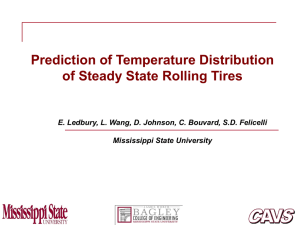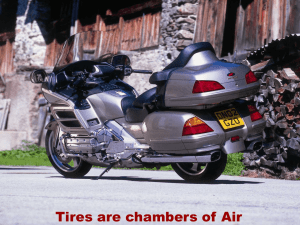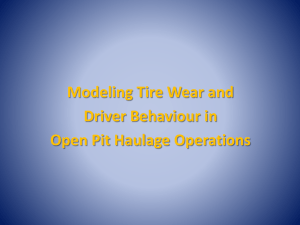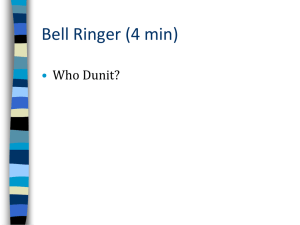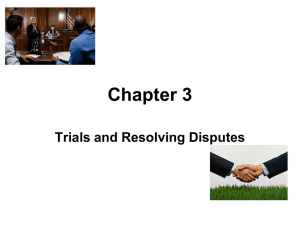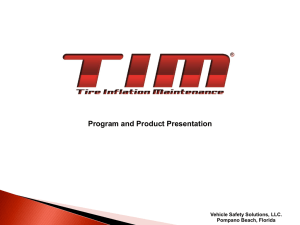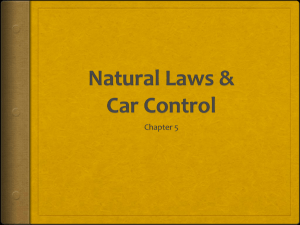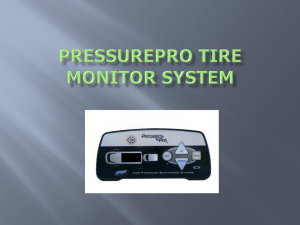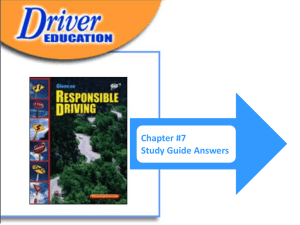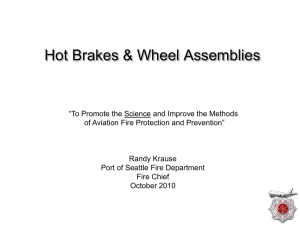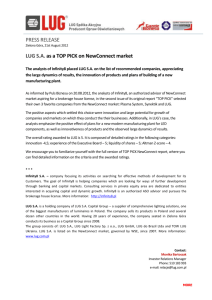Vehicle Maintenance
advertisement
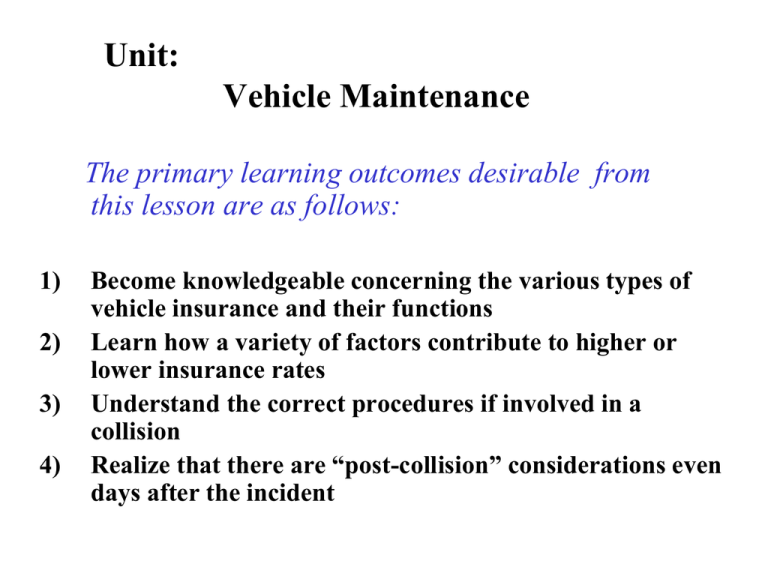
Unit: Vehicle Maintenance The primary learning outcomes desirable from this lesson are as follows: 1) 2) 3) 4) Become knowledgeable concerning the various types of vehicle insurance and their functions Learn how a variety of factors contribute to higher or lower insurance rates Understand the correct procedures if involved in a collision Realize that there are “post-collision” considerations even days after the incident There are many things that you can do to keep your car in good condition, but there are some things that need to be left to mechanics. This lesson will focus upon things the average person, with a little knowledge and desire, can do to help maintain their car in good operating condition. Power Systems Ignition/Electrical System Involved in the ignition process and provides electrical power needed to operate a vehicle. Lubrication System The use of oil, grease, and other substances to reduce damage to moving parts from heat caused by friction. Cooling Systems Provides additional cooling and source of heat for your vehicle’s interior in cold weather. Emission System Takes the exhaust created by burning fuel and forces it through the exhaust system to outside of the vehicle. What You Can Do • • • • • • • Check your tire pressure Rotate your tires Check and change your oil Check and fill various fluid levels Replace air filter, fuses Changing bulbs and lights Change a flat tire, jump start a car Checking Tire Pressure (check at every fuel fill up) • To check your tire pressure first unscrew the air cap What off of the tire rim. do you • Then use a pressure gauge know to check your tire pressure about and compare it to the checking sticker on the inside of the tire door. pressure? • If your tire pressure is low, you should add air to your tire as recommended. Checking Tire Pressure • Some newer cars will alert you when your tire pressure is low by displaying it on the dash board. • It is also a very convenient way to check your tire pressure. Tire Rotation (usually about every 5000 miles) • Tire rotation will allow your tires to last much longer. What • Refer to your vehicles users manual do you for the properknow tire rotation patterns and for how about often they should be rotated. tire rotation? For you to do this job you’ll need these . . . • To check your oil, first pop the hood What • Find your dipstick, pull it out do and youwipe it off with a rag. know • Reinsert it. Then pull about it back out and check checking the level of oil on the dipstick.your • Add oil ifoil? you are 1 quart or more down from “full” Checking Your Oil Adding oil How often should you change the oil? • First locate the oil fill cap under the hood. • Remove the oil fill cap. • Add the proper type of oil according to the owners manual for your car. (an oil funnel will keep drips to a minimum) When To Change Your Oil About every 3,000 - 5,000 miles or 3 months See owners manual for specifics Checking Brake Fluid What are warnings of bad brakes? What do you know about checking the brake fluid? • If your brake warning light is on and your parking brake is not set then you may have a problem with your braking system • If you notice a squealing noise when braking it could mean your brake pads are worn and need replacing. Bad Brakes warning What is the usual color of windshield washer fluid? Checking Windshield Washer Fluid Engine Temperature Gauge reads hot • You should frequently check your temperature gauge while driving. • If your car begins to overheat, especially in hot weather you should turn on the heater and fan on high; if the engine temperature does not soon lower you should pull over and let your car cool down. Engine Temperature • After the engine has safely cooled down (it may be an hour) remove the radiator cap. • If the fluid level is low add a 50/50 mix of anti-freeze and water. Power steering Water: usually fluid: check system condensation Motor oil: check under engine Coolant: check water pump, radiator or hose Transmission fluid: check under car…back part of engine Know your fluids • If you notice fluids under your car where it is normally parked, than you most likely have a leak which needs to be professionally checked out. Changing air filter • Air filters come in various shapes and sizes. It What is recommended that they changed dobeyou about every 30,000 miles know about • It’s usually a simple changing procedure removing an air of filter? (more frequently in dusty conditions) of a wing nut or some screws Things better left to professionals (unless you’ve had special training and have access to the proper equipment) • Major tune-ups: often require technical equipment • Engine problems: noises, fluid leaks; odors, broken belts, hoses, vibrations • Transmission problems • Rotating tires • Brake jobs • Radiator flushing • Air conditioning • Exhaust / steering system • Most electrical problems Emissions Testing • Since cars are the largest cause of carbon monoxide pollution and smog, they need to be tested to pass What emissions tests to keep our air clean. do you know about Emissions Testing? • Pull off the road so that you are safely out of the flow of traffic • Try to stop on a straight part of the road, (onto the shoulder) so that passing traffic can see you from a distance • Turn on your hazard flashers In Motion magazine, a General Motors publication Your tire blows out… What do you do? Jack lug wrenchWhat tools are needed to change a tire? Spare tire Safety Note: A car can slip off of a jack, so never put yourself in a position where the car could fall on you. 1. Shift to Park Set the parking brake 2. Block the wheel that is diagonally opposite the flat tire. Use a block of wood or a large rock to firmly secure the wheel. 3. Take out spare tire, jack, and lug wrench. (they may be in the truck – consult owner’s manual for exact location) Position jack under the car according to instructions. 4. Jack up the car high enough so the flat tire still touches the ground. 5. Remove the wheel cover or hubcap and loosen the lug nuts. Some cars do not have hubcaps...consult your owner’s manual for proper instructions in removing the tire Sometimes the lug nuts are tight and difficult to loosen… If you can't loosen them, try putting some of your weight on the lug wrench to loosen them 6. Jack up the car until the flat tire completely clears the ground. Use the lug wrench to completely remove the nuts and place them in the wheel cover. You will want the flat tire about 6 inches off the ground because the spare tire is fully inflated and will require more ground clearance 7. Removing the wheel – It’s easiest to grab the tire at the 9 and 3 o’clock positions - Pull the wheel straight toward you, and off the car • 8. Position the spare tire directly in front of the wheel well • Lift the spare tire and position it on the threaded bolts • Push the tire onto the car until it cannot go any farther • Replace the lug nuts on the bolts and tighten them, but not too tight...just enough to hold the tire in place while you lower the car • 10. Lower the car with the jack until the car is again resting on all four tires • Alternately tighten the lug nuts • Lower the car with the jack until the car is again resting on all four tires • Alternately tighten the lug nuts • Lower the car and put on the wheel cover 4 1 2 3 Safety Note: Do not use smaller spare tire for more than 50 miles.
